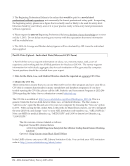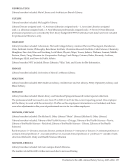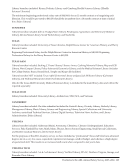Salary Survey Trends 2013–2014 · 13 average higher pay. In keeping with the 2012–2013 data, there are seven categories where women, on average, have more experience and less pay: Associate Director, Administrative Specialist, Digital Specialist Head, Rare Books/Manuscripts/Special Collections Head, Library Technology Department Head-Other and Public Services. Table 22 further reveals that the average salary for men is consistently higher than the average salary for women in all ten experience cohorts. Among minority librarians, the pattern is the same (see Table 39). There is a sense that the gender gap persists in academe in areas beyond the library and that a renewed commitment to resolve the problem is needed.3 A variety of reasons have been offered as to why these trends persist, most notably the perception that work is peripheral in a woman’s life and, consequently, female- dominated professions are undervalued. Librarianship is predominantly and persistently a woman’s profession. The scarcity of men in the profession has been well documented in many studies — the largest percentage of men employed in ARL libraries was 38.2% in 1980–81 since then men have consistently represented about 35% of the professional staff in ARL libraries. The Specialist Breakdowns The job categories and job codes for the university libraries in the ARL Annual Salary Survey 2013–2014 reflect the continued revision and modernization of the survey, a process that began with the 2012–2013 survey under the direction of the Task Force on Reviewing the ARL Statistics, the ARL Annual Salary Survey, and the ARL Supplementary Statistics. A new code was added to the Digital Specialist category: SS for Digital Specialists with Subject expertise, and four new codes were added to the Subject Specialist category: HFA, SCI, SBS, and AREA for the Humanities/Fine Arts, Sciences and Technology, Social/Behavioral Sciences, and Area Studies, respectively. For each of the new job codes, ARL institutions were offered two options: either use one of the new job codes to describe that position or, if none of the new job codes could adequately describe that position, use one of the broader category job codes: FSPEC, ADMSPEC, or DIGITALSPEC. As seen in the revised Figure 4, which now includes all positions, the category that includes Administrative Specialists (no subgroup) makes up 2% of the dataset the category that includes Digital Specialists (no subgroup) makes up 1.0% of the dataset, and the category that includes Functional Specialists (no subgroup) makes up 2% of the data set. Archivists comprised the largest percentage of Functional Specialists who used an alternative code (5.8%), and Information Technology specialists comprised the largest percentage of Digital Specialists who used an alternative code (9.1%). 3 There are many instances citing the continuation of gender inequity in academia. See, for example: Mary Ann Mason, “Still Earning Less,” Chronicle of Higher Education 13 January 2010 http://chronicle.com/article/Still-Earning-Less/63482/ Katherine Mangan, “Women in Academic Medicine: Equal to Men, Except in Pay,” Chronicle of Higher Education 31 March 2010 http://chronicle.com/article/Women-in-Academic-Medicine-/64892/ Paula Wasley, “ Gender Gap in Pay Widens Over Time,” Chronicle of Higher Education 4 May 2007 http://chronicle.com/article/Gender-Gap-in-Pay-Widens-Over/9208/ Denise K. Manger’s articles in the Chronicle of Higher Education, “Faculty Salaries Increased 3.7% in 1999–2000” (14 April 2000: A20) and “Faculty Salaries are Up 3.6%, Double the Rate of Inflation” (23 April 1999: A16) D. W. Miller, “Salary Gap Between Male and Female Professors Grows Over the Years, Study Suggests,” Chronicle of Higher Education, Today’s News, 27 April 2000 and Yolanda Moses, “Salaries in Academe: The Gender Gap Persists,” Chronicle of Higher Education 12 December 1997: A60.










































































































































































